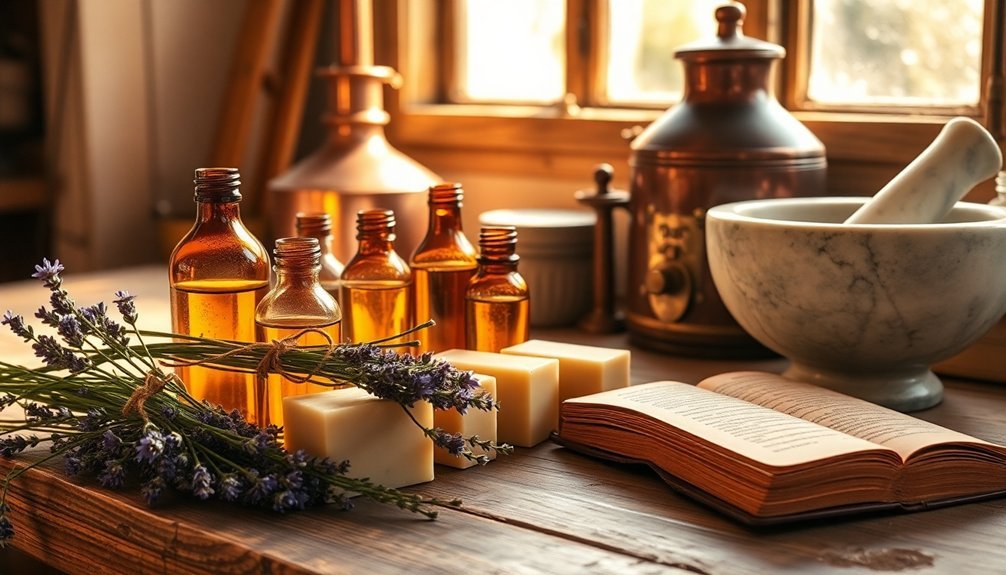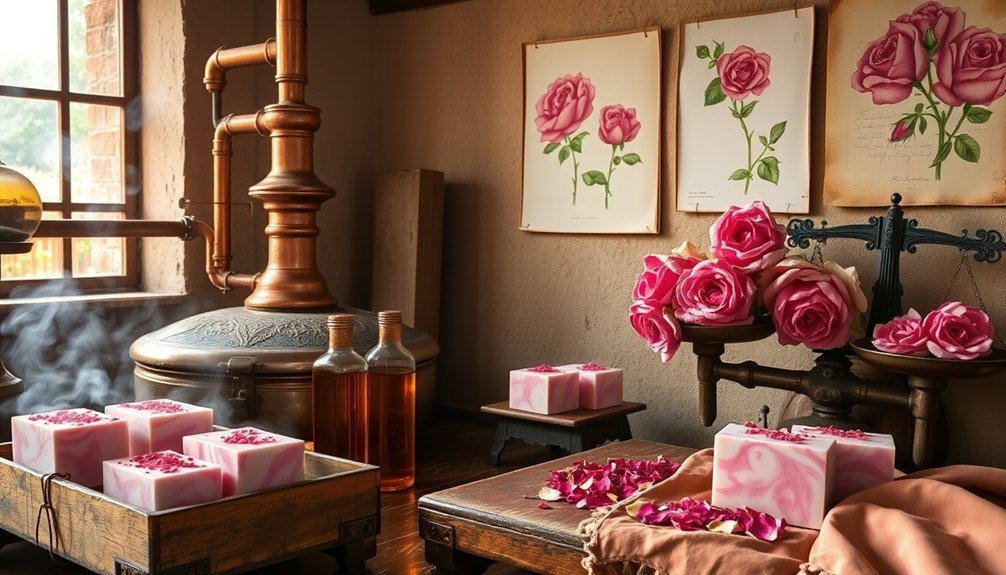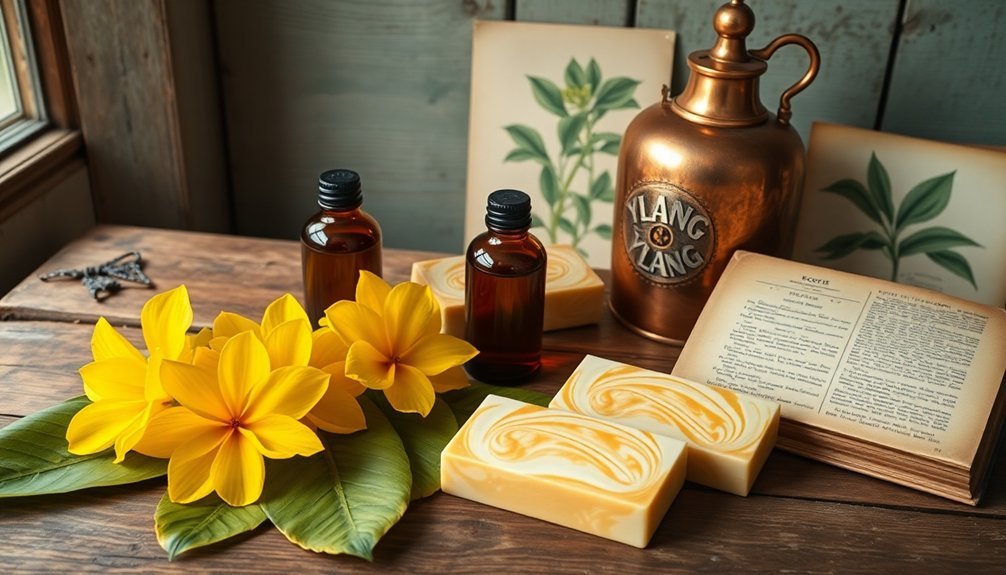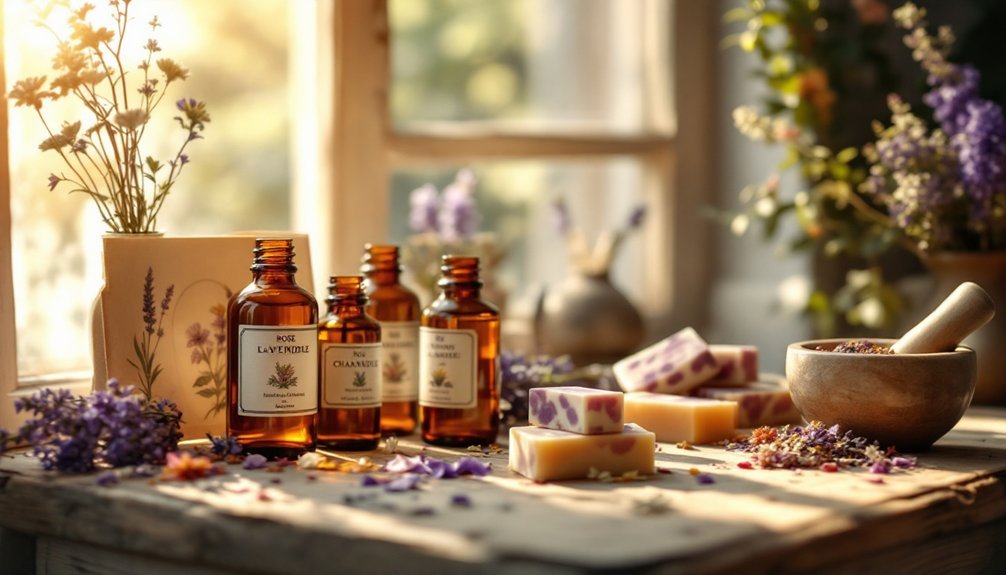The three best historic floral oils for soap making are lavender, rose otto, and ylang-ylang. Lavender offers relaxation benefits and antimicrobial properties, making it a staple since Roman times. Rose otto, though expensive, transforms ordinary bars into luxurious heritage soaps with moisturizing benefits. Ylang-ylang provides exotic fragrance with antibacterial properties that complement other scents. These traditional essences not only enhance your soap's therapeutic value but also connect your creations to centuries of aromatic craftsmanship.
The Timeless Allure of Lavender in Traditional Soap Crafting

While many floral oils have come and gone in popularity, lavender has remained a cornerstone of soap making since ancient Roman times.
When you incorporate lavender essential oil into your soap crafting projects, you're tapping into centuries of aromatic benefits that promote relaxation and stress relief.
For best results, blend 0.5-1 ounce of lavender essential oil per pound of soap base to guarantee proper skin safety while maintaining its signature fragrance.
You'll find that adding dried lavender buds enhances both visual appeal and provides gentle exfoliation.
Beyond its calming properties, lavender's antimicrobial and anti-inflammatory properties make it functional as well as luxurious in traditional soap making.
This dual benefit explains why lavender continues to captivate both crafters and users seeking therapeutic skincare solutions.
Rose Otto: The Royal Essence for Luxurious Heritage Soaps

Known as the queen of essential oils, Rose Otto commands respect in the soap making world with its incomparable depth and complexity. At $500-$1200 per ounce, this precious oil transforms ordinary bars into luxurious heritage soaps worthy of premium markets.
When you incorporate Rose Otto into your recipes, you're not just adding a divine floral scent – you're including centuries of therapeutic properties. Steam distillation preserves the essence of Rosa damascena, delivering moisturizing benefits that soothe inflammation and nurture sensitive skin.
The rich aroma creates a spa-like experience that elevates your soap crafting to an art form. Your customers will appreciate how this royal essence promotes emotional well-being while pampering their skin, making Rose Otto an investment that distinguishes truly exceptional handcrafted soaps.
Ylang-Ylang: An Exotic Tropical Treasure for Classic Soap Artistry

From the royal gardens of Europe to the lush islands of the South Pacific, we now explore the enchanting ylang-ylang oil. This essential oil, extracted through steam distillation from Cananga odorata flowers, offers you a sweet, exotic fragrance perfect for elevating your soap making projects.
You'll find "Ylang Ylang Complete," the first extraction, provides the highest quality for your artisanal soaps. Its notable skin-care benefits include antibacterial and anti-inflammatory properties, making it ideal for sensitive skin formulations.
When crafting soaps, try blending ylang-ylang with other floral oils or citrus notes to create sophisticated scent profiles.
Beyond its mesmerizing aroma, this tropical treasure brings aromatherapy benefits to your creations, promoting relaxation and stress reduction—a tradition spanning centuries in various healing practices.
Frequently Asked Questions
What Was Used for Soap in the 1700S?
In the 1700s, you'd find soap made primarily from animal fats like tallow or lard mixed with lye from wood ash. You'd also see early incorporation of floral oils for fragrance and skin benefits.
What Is the Best Oil to Use in Soap Making?
You'll find olive oil is the most versatile base for soapmaking. It creates a mild, conditioning bar. Coconut oil (15-33%) adds lather, while castor oil (5-10%) contributes creaminess and bubble stability to your soap.
What Is the Oldest Recipe for Soap?
The oldest soap recipe you'll find dates back to Babylon around 2800 BC. They'd mix fats with ashes and water, recording this process on clay tablets—a simple but effective formulation for basic cleansing.
What Is the 30/50/20 Rule for Essential Oils?
The 30/50/20 rule guides your essential oil blending: use 30% top notes for initial scent, 50% middle notes for the core fragrance, and 20% base notes to anchor and extend longevity in your products.
In Summary
You've discovered three historic floral oils that have stood the test of time in soap making. Whether you're drawn to lavender's calming versatility, rose otto's luxurious elegance, or ylang-ylang's exotic depth, these essential oils carry centuries of soap crafting wisdom. As you blend these timeless scents into your creations, you're not just making soap—you're continuing a fragrant tradition that connects you to artisans throughout history.





Leave a Reply